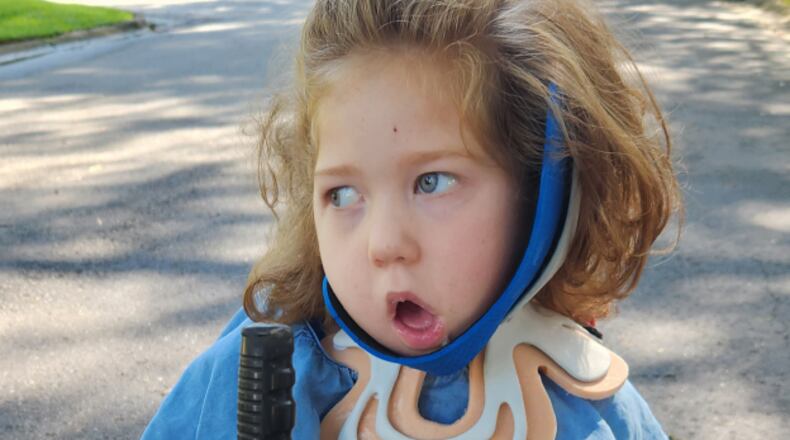Eight-year-old Catherine Reed can hold her head up unassisted for the first time in her life, thanks to a customized neck brace created by cutting edge 3D technology.
Catherine’s mother, Mary, knew something wasn’t right the second she was born via cesarean section.
“My first two kids came out screaming, but Catherine was completely silent,” said Mary, of Sandy Springs. “Her muscles were extremely floppy, and she was gray.”
As a nurse took newborn Catherine away to be worked on, Mary yelled, “Is she alive? Is she alive?”
“To be honest, she did not look alive, but the nurses saved her life,” said Mary. “They got her color back.”
During a 13-week stay at Children’s Healthcare of Atlanta immediately after her birth, Catherine received a litany of diagnoses. Doctors told Mary and her husband, Rob, that Catherine’s seventh craniofacial nerve did not develop properly in her brain, which means her brain is unable to communicate to the muscles throughout her body. Because of this, her muscles are very weak and incapable of supporting her. Further, her jaw did not develop typically, she doesn’t have the reflux to swallow and her face is partially paralyzed.
She was 7 days old when she had her first surgery, a procedure to bring her jaw forward to help her breathe, and she’s had so many surgeries since that her parents have lost count.
Courtesy of Mary Reed
Courtesy of Mary Reed
At 8 years old, her days are just as harrowing as they were during infancy.
“We’re still on survival mode, taking one day at a time,” said Mary, who laughs when asked what normal looks like for their family. “Things change at the drop of a hat. Just this month alone she’s been in and out of the hospital three times. The word normal is relative, I guess.”
Catherine attended school for a few years but does not anymore. She would need a one-on-one, very skilled nurse on high alert all day and availability is slim, Mary said. In lieu of school, her days are filled with physical, speech and occupational therapies. At home, Mary focuses on sensory activities, like music and outings.
Catherine is nonverbal and, because her face is paralyzed, she is unable to smile. However, her mother can read her like her favorite book. She knows what her little girl doesn’t like (certain therapy exercises) and she knows what makes her happy.
“Catherine loves being outside,” said Mary. “I take her to outdoor concerts, and she loves going to the Atlanta Botanical Garden during the holidays to see the lights. She also loves to paint and create art.”
Most of all, Catherine loves when her older siblings, both college students, are home and she’s in the midst of the excitement.
Courtesy of Mary Reed
Courtesy of Mary Reed
“Catherine wants to be in the middle of conversations,” said Mary. “We aren’t quite sure how much of it she understands, but she loves when people talk to her. When she seems irritable, I’ll pick her up and talk with anyone in the house, because it calms her and makes her feel included.”
Engaging with others has been extra difficult for Catherine since she is unable to hold her head up on her own. Someone props her just right if she is sitting and, when she rides her adapted bicycle, it takes two hands to assist her, one to push the bike and another to hold her head.
About a year ago, after observing the struggle this caused Catherine’s caregivers and seeing that soft braces did not offer enough support for Catherine’s head, a physical therapist suggested a firm, custom brace, also referred to as a collar. Catherine already relies on a back brace, hand braces and braces for her lower extremities used strategically throughout the day, so Brian Emling, an orthotist-prosthetist at Children’s who has worked with Catherine for years, came up with a solution to give Catherine independent head control.
“We’ve been doing 3D printing in-house for about seven years,” said Emling. “Our leaders have all recognized how beneficial it is, especially in pediatrics because the anatomy is so unique, the needs are so unique and they require unique solutions.”
Emling custom-designed and printed a collar on an HP Multijet Fusion Printer that uses powdered nylon. The nylon powder is sprayed by a catalyzing agent then heated to make it solid. The process is done layer by layer until the process is complete. The final product has been life-changing for Catherine.
“She has responded to the collar so well,” said Mary. “It gave her a new perspective of the world. She is seeing things independently and I’m eternally grateful to Brian for going above and beyond for her. With her head in neutral and not flopped to the side, she can see the world around her. It makes her more approachable; it makes it more likely that people will come up and say hello. The impact is so significant.”
Emling said he did not appreciate how valuable the collar would be for Catherine’s providers, allowing them more ease when caring for her.
“Now they can take her out on her bike with a free hand to have a cup of coffee, take a picture of her or protect her if she were to fall,” said Emling. “But my greatest hope is that the collar continues to allow Catherine the opportunity to interact in her environment, to sit peacefully and observe life. I want her to be able to sit in the park, watch clouds go by, see the squirrels play and take that in. It’s so simple — something many of us take for granted — but it’s beautiful and I want that for Catherine.”
About the Author







